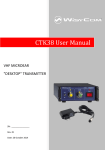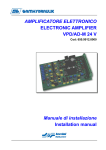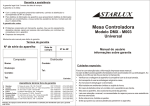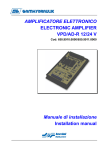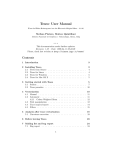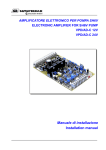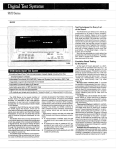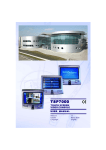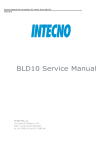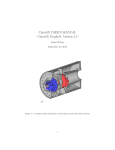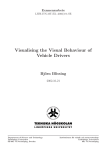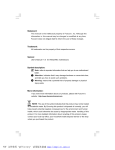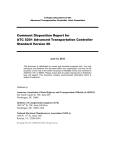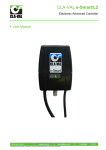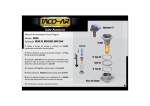Download CD180 Service manual
Transcript
AXOR High Performance Servo Drives Special function AXOR High Performance Servo Drives 7.1 Examples (cont.) Example with Speed control differential output stadio. Example with speed control in common mode output stadio. Version : M-CD-GB01 Service Manual CD180 Service Manual CD180 AXOR Special function High Performance Servo Drives AXOR High Performance Servo Drives 7.1 examples (cont.) CAUTION! ELECTRICAL AND CONTROL EQUIPMENT MAY BE DANGEROUS IF HANDLED IMPROPERELY This manual show mechanical and electrical charateristics about CD180 series. It is important, that the installation procedure should be performed only by qualified personnel according with local safety rules. Who installs the equipment must follow the technical information cantained in this manual. For other informations please contact AXOR technicians. Examples: reference connection from internal or external source. NOTE: the creens oh the reference cables and of the tachogenerator have to be connected to the terminal n.14 0S of the converter. Joint to be avoided. From the terminal n.14 you have to start with the mass connection. Ext. source External one-polar supplier Int. source ATTENTION ELECTRICAL DISCHARGE DANGER Ext. source External bi-polar supplier 2 Service Manual CD180 Service Manual CD180 Int. source 27 AXOR High Performance Servo Drives Special function AXOR High Performance Servo Drives Index 7.1 Examples (cont.) 1) Descriptions 1.1 1.2 1.3 1.4 1.5 1.6 EXCLUSION LIMIT I EXT. With terminal n.9 and n.10 connected, the external limitation is excluded. With terminal n.9 free, limitation is totally inserted. I = 0A Introduction .......................................................................... Technical informations......................................................... Applications......................................................................... Dimensions.......................................................................... Functional diagram............................................................... Connection diagram............................................................. pag. 4 pag. 5 pag. 5 pag. 6 pag. 7 pag. 7 2) Connectors 2.1 Signal connector.................................................................. pag. 8 3) Signalling and calibrations With : S1 open = limit. I ext. inserted = 0A S1 closed = limitation programmable with P1 from 0% to 100%. P1 = 3Kohm min. 3.1 Personal card...................................................................... pag. 10 3.2 Signal led............................................................................. pag. 12 3.3 TP diagnostic connector...................................................... pag. 13 4) Installation 4.1 Power wiring....................................................................... pag. 15 4.2 Signal wiring (4.2a 4.2b ecc.)............................................. pag. 15 4.3 External components dimensionality.................................... pag. 16 5) Starting procedure With: S1 pos. A = lim. I ext. excluded (I=100%) S1 pos. B = lim. I ext. inserted. The I can be programmed according to the formula: 5.1 5.2 5.3 5.4 R1(Kohm)=(3.3xImax)-3.3 where Imax=Imax CD I richiesta 6) Faults Preliminary controls............................................................. Starting procedure.............................................................. Calibrations.......................................................................... Options................................................................................ pag. 18 pag. 19 pag. 20 pag. 22 6.1 Faults research................................................................... pag. 24 R2= 3.3Kohm 7) Special functions 7.1 Examples............................................................................. pag. 25 26 Service Manual CD180 Service Manual CD180 3 AXOR High Performance Servo Drives Descriptions 1.1 Introduction Special function AXOR High Performance Servo Drives 7.1 Examples C.N.C. Transistor switching converters to control DC permanent magnet motors. Thanks to the easiness of installations, the semplicity of operations and the considerable varied range of performances available, our articles perfectly come up to the current request of the market. Because of the autogeneration of the internal auxiliary voltages, a three phase transformer, with only one secondary, is necessary for their supply. The 5 KHz frequency modulation allow the elimination, nearly in all motors, of the inductance series of the additional levelling. As all the equipments are internally self ventilated, an exterior blower cooling (and the consequent additions of rack) is not needed. Rated current is guaranteed up to a room temperature of 40°C for all the sizes. Braking unit to carry of the energy of the motor during the recovery phase, ar internally set. Inputs and outputs, either of power or signal, are completely available on the frontal. All the above characteristics enable these moduls to suit also the multiaxis executions. To guaranteed the max. security of the external operator and the freedom of connection, the power stage is separated from the control circuits in a galvanic way. The converter is self-protected against autput short-circuits between the terminal motor. In case of anomaly, the operations of the equipment is stopped by an internal diagnostic circuit. It intervention is memorized and externally reported by a green led. When the position of the led is in ON, the converter is all right. To restore the allarm it is necessary to take away and return the voltage to the set. The protection of the motor is provided with the limitation of effective current. When the max. cycle of loading exceeds, an internal limits takes effects; this is externally signalled by a red led. When the position of the led is ON , the limithas not intervened. To protect motor at high revolutions, the max. current limitation function depending on the speed, is available. All the external calibrations are available on the frontal and set on a removible card. This makes our equipments perfectly interchangeable on the same size. Es. : reference connection from external multiaxis CNC source 4 Service Manual CD180 Service Manual CD180 25 AXOR Faults High Performance Servo Drives Descriptions AXOR High Performance Servo Drives 1.2 Thecnical informations 6.1 Faults research MODEL 1) After giving predisposition and with the converter supplied, the motor accelerates uncontrollably: in this case it is possible thet the connection between tachogenerator and plate motor is inverted or even lacking or broken. In presence of M.d.t. (tacho lacking), the motor starts its accelòeration but after some turns the frontal L1 led turns off (CONV.OK) and the motor stops in a time depending on its mechanic inertia. At this point it is convenient to check the tachogenerator connection. 2) Givin voltage, the MAX.REC., or max voltage, opens: check using e tester, the output voltage of the supply transformer, which is probably too high. 3) In braking or motor deceleration phase, the MAX.REC. contact turns on: Probably a too high PD2 has been given to the driving shaft. 4) In acceleration motor phase the green led L1 (CONV.OK) turn off and the motor stops for inertia: the supply transformer power in not enough or its voltage short-circuit is too high. 2 5) In operating cycle the red led L2 (I t) turns on and the motor loses torque: the operating cycle is too hard and the motor is working more than its rated-torque charateristic. 6) With supplied working switched on predisposition and OK led lighted, the motor does not turn: check the terminal n.9 relative to the external current limit. If the voltage compared to the terminal n.14 is 0 volt the current in the motor is 0A. Connect suitably this terminal. For an easy search of the alarm causes, use the proper SINOPTYC card, and the relative booklet given under request. The characteristics can be modified without notice. CD180 CD180 CD180 CD180 CD180 CD180 RATED CURRENT PEAK CURRENT 8A 15A 25A 30A 50A 50A 16A 30A 50A 75A 100A 150A 8/16 15/30 25/50 30/75 50/100 50/150 MAX. OUTPUT VOLTAGE +-200V +-200V +-200V +-200V +-200V +-200V Characteristics * * * * * * * * * Frequency of 5KHz switching Working frequency at current loop = 1 KHz Room temperature allowed = 0 ÷ +40C° Tolerance on the power supply voltage = + 10% Differential analogic reference input = + 10V Input impedence = 24 KOhm Logical input signal of opto-isolated enable inputs Output signal available in clean contacts Peak current available for 5'' until intervention I2t Dinamic protections * * * * * * * * * Short - circuit motor (memorized) Max recovery cycle with release of power remote - control switch Min-Max supply voltage ( memorized) Max internal temperature (memorized) Internal anomaly diagnostic (memorized) Broken or inverted tachometer protection available (memorized) Dinamic braking againts blakout conditions available I2 x t function for thermic motor protection Imax limitation at high speed function 1.3 Applications * * * * * * * 24 Service Manual CD180 Axis translations for tool machines Machines to copy Various system of movements Industrial robot Positionings Transfer lines General need of very linear and accurate regulations Service Manual CD180 5 AXOR Descriptions High Performance Servo Drives 1.4 Dimension Starting procedures AXOR High Performance Servo Drives 5.4 Options (cont.) R.m.v. RELAY OUTPUTS OF MIN. SPEED The signal of operating motor is indicated by a NO contact having its common on the terminal n.4 and the output on the terminal n.2 of the signal connector. For the regulation of the intervention threshold, see par. 3.1.2. POLARITY OF CONNECTIONS To prederminate the right use of the motor rotation go on as follow: 1) The driving shaft has to be clockwise rotated by hand. It must be electrically unlinked to the converter. Using a texter, point out positive and negative polarity of the plate. 2) On the same conditions (as above) keep on rotating the driving shaft, again by hand, and point out the polarity of the tachogenerator. 3) Link the positive of the motor plate to the terminal +M of the converter and the negative to the terminal -M. Link the positive of the tachogenerator to the terminal n.13 (+DT) and the negative to the terminal n.12 (-DT) of signal connector. Putting on a positive reference on the terminal n.16 (-RIF) in comparision with the terminal n.15, the motor will rotate in a clockwise way. If the plate motor is wrongly connected to the tachigenerator, the motor can go in "escape" it means it is working uncontrollable, at the max speed and in a too short time. That is why, to avoid mechanics demages, it is recommended to operate with the driving shaft stopped. Terminal board power Test point connector Signal connector Signal leds Calibrations trimmers REFERENCE COMMON MODE When a signal in differential mode is not used for the reference it is necessary to connect the terminal n.15 (+RIF) to the "0S", terminal n.14. BLOWER COOLING CONVERTERS MODEL L1 L2 L3 CD180 8/16 - 12/24 CD180 15/30 - 25/50 - 30/75 CD180 50/100 - 50/150 66 99 132 33 65 97 203 204 210 Dimensions are in mm. 6 Service Manual CD180 All the converters, if necessary, are alredy internally ventilated. No external set is needed. But in case of more set placed over, the min. distance between the converters has to be at least 15cm. ENVIROMENTAL CONDITIONS For all the sizes, the rated current is guaranteed up to a room temperature of 40°C. In any case it is recommended not to exceed an operating room temperature of 60°C. In case of dusty places, it is necessary to keep the equipments inside electrical limits suitably filtered. Service Manual CD180 23 AXOR High Performance Servo Drives Starting procedure Descriptions AXOR High Performance Servo Drives 1.5 Functional diagram 5.4 Option TEST POINT The TP connector on the frontal of the set, provides a series of logical signal to be texted by a special synoptic alarm detector. It is available under request. TYPOLOGY CONNECTION To avoid anomalies on operation, it is recommended to follow these proceedings. POWER CONNECTIONS the connection between the transformer and the drive must be carry out with suitable section cables. This is valid also for the motor connection. Medium currents must be considered in the calculation. In addition a fast fuse tern in series at the secondary of the transformer for every converter must be provided. As for the dimensionality, see the relative table. 1.6 Connection diagram SIGNAL CONNECTIONS The tachogenerator and signal reference connections must be screened, the shields have to be linked to the terminal n.14, "0S". At this point, it is possible to effectuate the grounding, as for the connection diagram. PREDISPOSITIONS The release of modulation (PWM.ON), of reference (REF.ON), and of ramps (RAMPS.ON), must be short-circuited with the "0P" (terminal n.8), to obtain the predisposition. OUTPUT SIGNAL The output signals from the converter are NO relay contacts. More exactly the common of the contacts is the terminal n.4 of the signal connector and the other contact head is the terminal n.1 for the MAX.REC. and the n.3 for the signalling of any anomaly, CONV.OK . With a set in good working condition, these contacts close after 2" from the supply and reopen only in case of anomaly. NOTE. The MAX.REC. contact has to adjust directly to power supply remote-control switch, as for connection diagram. If not, serious demage to the set can occure because of excessive tolerance on the max, voltage of the supply. See also pages 15 and 16. 22 Service Manual CD180 Service Manual CD180 7 AXOR Connectors High Performance Servo Drives 2.1 Signal connector Starting procedures High Performance Servo Drives 5.3 Calibrations (cont.) DENOMINATION TERMINAL N° DESCRIPTION MAX REC. 1 Output: internal ralay contact relative ti the max dynamic braking cycle alarm. It can carry out a max voltage Vac = 110/115V, or Vdc = 48V with a max current of 800mA. With supplied converter 7) ACC/DEC RAMP CALIBRATION If request, the ACC/DEC ramp circuit is available. Incline variations are possible adjusting the T8 trimmer available on personal card. Clockwise rotation produces a decrease of the ramp time (from 1" to a min. value of 0.1"). The max. ramp time of 1" can be extended by introducing a C1 capacitor on the personal card. Under request it is also available a switching on/off finction ramp stage provided with a logical signal on the outside terminal n.7 of the signal connector. These optional finction, if wanted, have to be request at the moment of the order. 8) BALANCING CALIBRATION To make up for eventual external off-sets on the reference signal (which causes a light rotation of the motor), operate on the T6-BAL trimmer to stop the rotation of the motor. The operation has to be carried out with reference signal = 0V. 9) LIMIT CALIBRATION OF EXTERNAL TORQUES It is possible to limit the current and as consequence the available torque at the driving shaft, bringing the terminal n.9 of the signal connector from +10V to 0V, as reported in the connection diagram. With +10V, 100% of the current torque is obtained, with 0V, the result is 0%. If this function is not request, it has to be excluded by bringing to 10V fixed the terminal n.9, or closing the interiour welding point n.S7. If interested, this function must be requested at the moment of the order. 10) EMERGENCY BRAKING If requested it is possible to obtain the fast dynamic braking against blackout conditions function which unables the interruption of the motor in case of blackout.To obtain this function it is necessary to stop the PWM.ON predisposition relative to the terminal n.6 of the signal connector, when the motor supply stops. In this way, the motor is controlled in fast braking until the min. speed threshold set. 11) ALARM RESTORATION To restore the alarm that has been used it is necessary to take away and return voltage to the converter. Before returning voltage it is necessary to wait 10", if not the used alarm keep on signalling even if the cause for its action is not present any longer. Contact in ON = OK Contact in OFF = intervent protection R.m.v. 2 Output: internal relay contact relative to the min. adjustable speed detector same loading as for MAX REC. Contact in ON = speed > min. speed Contact in OFF = speed < min. speed OK 3 Output: internal relay contact relative to the intervention of any alarm but MAX REC, it is memorized. It is restored by taking away and returning the voltage. Same loading as for MAX REC and R.m.v. Contact in on ON = protection OK Contact in OFF = protection intervened COMUNE 4 Output: common of the contacts relative to the terminal 1, 2 and 3. RIF. ON 5 Input: predisposition to signal of reference electrically separated by opto insulator. To be obtain bring this terminal to "0P". PWM. ON 6 Input: predisposition to modulation, electrically separated by opto insulator. To be obtained, bring the terminal to "0P". 8 AXOR Service Manual CD180 Service Manual CD180 21 AXOR High Performance Servo Drives Starting procedures Connectors AXOR High Performance Servo Drives DENOMINATION TERMINAL N° DESCRIPTION RAMPE ON 7 Input: predisposition to acceleration and deceleration ramps, electrically deparated by opto insulator. To be obtain bring the terminal ti "0P". With RAMPE ON = L = on With RAMPE ON = H = off OP 8 Output: zero for predisposition. LIM.I.EST. 9 Input: Current programming from outside by a voltage from 0 to +10Vdc, equivalent to a limitation from 100% to 0%. + 10V 10 Output: voltage available on the outside. Imax = 8mA. - 10V 11 Output: voltage available on the outside. Imax = 8mA. THRESHOLD CALIBRATION R.m.v. MIN SPEED RELAY R.m.v. circuit offers a clean NO contact available between the terminals n.4-COMMON and n.2-R.m.v of the signal connector. This contact closes then the tachogenerator exceed the level set up by the T7-R.m.v. trimmer on the personal card. Regulation fields included between the 0% and the 10% of the max. speed. - D.T. 12 Input: tachogenerator. + D.T. 13 Input: tachogenerator. 5) CALIBRATION K.V. DYNAMIC PROFIT SPEED STAGE It is obtained checking the T3-K.V. trimmer on frontal. Clockwise rotation increases the system answer. OS 14 Output: zero signal for the connections of screes and c.n.c.. 6) DERIVATE TACHOGENERATOR CALIBRATION The T4-DER trimmer on the frontal introdeces a lead regulation on the tachogenerator signal toward the collation knot with the reference signal. Clockwise rotation increases the derivative effect. + RIF. 15 Input: Not-reversing input, differential reference. - RIF. 16 Input: reversing input, differential 5.3 Calibrations 1) RATED CURRENT CALIBRATION In It is obtained by inserting on the personal card a resistance called Rx, whose value is given by the following formula: RX in KOHM = 2874 x I nom. 2 I max 2 The max. time peak of the current depend on the ratio Imax/In. In any case it decrease according to the loss of In set in. 2) 3) 4) MAX. CURRENT CALIBRATION Imax IN FUNCTION OF THE SPEED Action is taken on the T1-R.P. and T2 R.S. trimmers to restrict the max current of peak motor turn function. In this case, the limits imposed by the switching bend of the motor itself, are not surpassed. For the right calibration, it is recommended to ask for aou technical office. RATED SPEED CALIBRATION The rated speed arrangement is rougly calculated by the DIP SWITCH on personal card (see speed range table), and precisely calculated adjusting the multiturns trimmer an the T5-SPEED frontal. In absence of particular specifications, converters are produced calibrated for a 10V reference at the rated motor speed. N.B. To take use of terminal 7 and 9, some internal weld point have to be executed by qualified personal. If the EXT.LIM.I is not used, it is necessary to connect the terminal 9 to +10V. 20 Service Manual CD180 Service Manual CD180 9 AXOR Signalling and calibrations High Performance Servo Drives Starting procedures AXOR High Performance Servo Drives 5.2 Starting procedures 3.1 Personal card All the external calibrations are available on the frontal and set on the removable card. - Keep the motor shaft free from load and be ready to switch off main power if necessary. Acc./Dec. ramp extension. I2t calibration. R.m.v. thereshold release. - Take out signal connector (from 1 to 16 marked) leaving connected wired to flying female connector. Acc./Dec. ramps. - Put in series fuses on alternate feeding. Return incline. ATTENTION: Calibration for qualified personel Return thereshold. Dynamic profit (KV). Derivative. Speed fine. Off-set. Speed range selection. Switching on-off lacking. Tachogenerator alarm. 3.1.1 Dip switch N° 4 Switching on/off alarm for lacking or inverted tachogenerator. N° 1,2,3 Speed range selection in binary system. The regulation fine inside each range in achieved by T5. - Insert signal connector and be sure that reference input is 0V. ATTENTION: when CNC driver the motor please use manual mode and not activated the error connector of CNC. - Switch on the three phases power and after abilitate the regulation: PWM on activated. (Is good rule normally to give abilitation OK after the main power switch on of converter). If motor stay on torque or it turn slittly, tachi polarity is correct. If tacho is inverted, after a low rotation, MD protection is activated "tacho loss or inverter tacho", disabling the converter. Switch off the amplifier, exchange tacho wires and start again. ATTENTION: a minimum amount of times ha to be taken betwees a stop and start again in order to be sure of a real switch off of driver. - Increase speed value signal to a minimum value of 1 Volt, and look to motor rotation direction. If motor turns wrong direction both polarity of tacho and motor must be inverted. - Now activate space loop of CNC, if one. If now we have the same working way as before closing lop of CNC, and CNC don't gives "following position error", the driver is correctly regulated. SPEED RANGE TABLE (Tachogenerator voltage) 10 - Switch on the driver. After 1 second about, on normal operation mode green led on will light on. Motor must be stopped. If mentioned led don't light, please verify with a tester the choosen alternate feeding value. Switch off the three phases feeding. 1 2 3 V.MIN V.MAX OFF OFF OFF OFF ON ON ON ON OFF OFF ON ON OFF OFF ON ON OFF ON OFF ON OFF ON OFF ON 4V 15V 25V 37V 46V 58V 68V 79V 24V 35V 44V 56V 65V 78V 87V 99V Service Manual CD180 - Now please make standard working cycles verifing thet no protections will go on. Service Manual CD180 19 AXOR High Performance Servo Drives Starting procedure 5.1 Preliminari controls Signalling and calibrations AXOR High Performance Servo Drives 3.1.2 Calibration trimmer The standard amplifier is provided as follow: DENOMINATION TRIMMER N° DESCRIPTION R.P. T1 Regulation of the incline intervention of the limitation current circuit of peak, in speed function. Anti-clockwise rotation increases the incline. R.S. T2 Regulation of the intervention thereshold of the current limitation circuit of peak in speed function. Clockwise rotation reduces the intervention thereshold. Anti-clockwise rotation leaves out the return function. This function unables to respect max. torque characteristic at high speed combinations of the permanent magnet motors. K.V. T3 Regulation of the dynamic profits or system promptness. Clockwise rotation increases the profits or the answer. DERIVATIVE T4 Lead regulation on the tachigenerator signal. Clockwise rotation increases the derivative effect. FINE SPEED T5 Fine motor speed regulation on the inside of the selectioned ranges by a dip-switch. Clockwise rotation reduces the speed. OFF-SET T6 Regulation of the zero setting speed in case of reference absence. - Nominal and peak current agree with amplifier's size. - Tachogenerator feedback. Verify all scew clamp connections (power and signal) and control the proper wiring an the amplifier. For motor and tacho polarity we will obtain clockwise direction with positive speed reference. Motor and tachogenerator polarity are those declared from factory. Now, we have 2 cases for CD180 starting procedure: 1) If the converter is adjiusted for its motor, go on chapter "Starting procedures", 2) If the converter isn't adjiusted consult chapter "Calibrations" and go on. 18 Service Manual CD180 Service Manual CD180 11 AXOR Signalling and calibrations High Performance Servo Drives 3.1.2 Calibrations trimmer (cont.) DENIMONATION TRIMMER N° Installation AXOR High Performance Servo Drives PROTECTIVE FUSES DESCRIPTION Fuses for the primary R.m.v. T7 ACC/DEC Regulation of the min. speed relay release thereshold. Clockwise rotation increases the theresold T8 Unique regulation for the ACC. DEC. ramp. Clockwise rotation reduces the time of the ramp. Normal fuses calculated according to the rated power of the transformer in KVA F1 = *sqrt3 = square root of 3 Pa (VA) Vprimary (sqrt3)* (A) Fuse for the secondary Fast fuses calculated and set up for every single converter to be used as following: F2 = 3.2 Signal led DENOMINATION LED DESCRIPTION OK L1 Green: Signal of the intervention of any alarm except for the MAX. REC., it indicates the opening of the OK contact (terminal 3). It is memorized and to be restored it is necessary to take away and return voltage. With L1 = OFF = allarm With L1 = ON = converter OK I2 t N.B. 12 L2 Red: Signal relative to the intervention of the effective motor current limitation. When operating, the peak current is not available. Its restoration comes at inverse time after the absorption has decrease below the rated current. With L2 = OFF = OK With L2 = ON = signal released CD180 8/16 CD180 15/30 CD180 25/50 CD180 30/75 CD180 50/100 CD180 50/150 12A 16A 25A 35A 50A 80A fast fast fast fast fast fast EXTERIOR INDUCTANCE SERIES if you want to drive motors with very low plated inductance (below 0.7 - 0.8mH) an exterior inductance to be linked in series if necessary. In this way an improvement of the current form factor is obtained as the overheating of the motor is avoid. The inductance values have been normalised depending on the converter size, as indicated in the table. CD180 8/16 CD180 15/30 CD180 25/50 CD180 30/75 CD180 50/100 CD180 50/150 LX1 LX1 LX2 LX3 LX4 LX5 The use of test point or diagnostic connector enables the discrimination of the exactly cause of a L1 alarm signal. Service Manual CD180 Service Manual CD180 17 AXOR Installation High Performance Servo Drives Signalling and calibrations AXOR High Performance Servo Drives 4.3 External components dimensionality 3.3 TP diagnostic connector Proceeded to be followed: It is set on the frontal of equipment. All test points are relative to logical levels, uncoupled by resistance in series at the outputs. 1,2 - 3,4 - 5,6 T.P. relative to +15V, -15V, 0P are excluded. A) Choise and dimension of the transformer B) Dimension of fuses C) Choise inductance series to the motor (only where necessary) ATTENTION: The use of the diagnostic connector is reserved to qualified personal. In any case for a quick test, the use (via flat cable) of the relative "problem guide" is recommend. SUPPLY TRANSFORMER fast - Voltage POSITION SIGNAL DESCRIPTION Primary voltage is linked to the line voltage available. The secondary voltage is calculated considering the characteristical datas of the motor you wont to drive.In any case it is very important included between a min. value of 110Vac (+ 10% of line) and a max. value of 170Vac (+ 10% of line) with empty transformer. The formula to obtain secondary voltage loading value is the following: 1,2 -15V Internal voltage supply -15V 3.4 +15V Internal voltage supply +15V Vac = (Vmot x 0,9) x 1,1 5,6 0P 0P 7 MIN/MAX T. Min/Max voltage supply alarm. With T.P.7 = L = int. protection. With T.P.7 = H = OK 8 DRIV. ALL. Alarm for summation of the power stage driver protection. With T.P.8 = L = int. protection. With T.P.8 = H = OK 9 M.D.T. Alarm absence or inverted tachogenerator. With T.P.9 = L = int. protection With T.P.9 = H = OK 10 S.T. Alarm opening thermostats caused by interior overtemperature. With T.P.10 = L = int. protection. With T.P.10 = H = OK Service Manual CD180 13 where Vmot=FCEM (with motor at the rated speed) + Ri (plate motor resistance with brushes) x In (rated motor current relative to the rated torque). In this formula we have supposed we can drive the motor also with -10% of line. To avoid driving motor problems in presence of high speeds and with max. loading, it is recommended not to exceed the 5%. - Power The rated power of the transformer is calculated according to the Vmot and the In of the motor (see previous notes). The formula is the following. P = Vmot x In where P = power in KW obtained at the secondary. In the presence of a multiaxis system, the power of the transformer is given by the sum of all single powers. In fact the real constructuin power of the transformer can be lower than the theoric one calculated as indicated above. In a tool machine where there are not very hard work cycles and with the axis not working at the same time and at the max. loading, the power can be reduced of 30/40%. The triangle secondary is recommended. 16 Service Manual CD180 AXOR High Performance Servo Drives POSITION Signalling and calibrations SIGNAL DESCRIPTION 11 MAX. REC. Alarm max dynamic bracking cycle in recovery. With T.P.11 = L = int. protection. With T.P.11 = H = OK 12 PWM.OK Predisposed modulation. With T.P.12 = L = OK With T.P.12 = H = modulation stopped 13 REF.OK Reference predisposed. With T.P.13 = L = OK With T.P.13 = H = reference stopped 14 RICH.PWM. Modulation request. With T.P.14 = L = modulation not request With T.P.14 = H = modulation request 15 ACC/DEC.OK Acceleration/Deceleration predisposed ramps. With T.P.15 = L = ramps switched off With T.P.15 = H = ramp switched on 16 + 10V.OK Alarm lacking +-10V supply. With T.P.16 = L = int. protection. With T.P.16 = H = OK N.B. 14 Installation AXOR High Performance Servo Drives 4.1 Power wiring NOTE: CD180 amplifier has several wiring connection which must be made in order to ensure the correct operation for reduce interferences. Use shielded cable for analogue and tachi signal. For wiring see cap. 7.1. Signals cables must be not together power wires, signals cables output should be own upper side power wiring output twisted together should be on lower side. 4.2 Signal wiring With H and L logical voltage levels are intended. H = 2/3 x 15V >=9-10V L = 1/3 x 15V <=4-5V Service Manual CD180 Service Manual CD180 15














